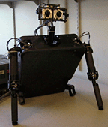



|
Approach
We propose developing the perceptual and intellectual abilities of
robots so that in the field, war-fighters can interact with them in
the same natural ways as they do with their human cohorts. To
illustrate our goals and illuminate the technical problems that we
must solve to achieve these goals, we will outline three scenarios:
- Showing a robot how to open the gas tank of an unfamiliar
captured enemy vehicle
- Instructing a robot to carry out a reconnaissance mission ranging
a few hundred meters from the command post within a strife-torn
downtown urban environment
- Instructing a dextrous forklift-like robot to load a truck by
showing it how the particular bulk food sacks should be stacked
together, one by one
Our approach is based on two key ideas; imitation and social interaction.
Imitation involves the robot watching and listening to a person
perform some task and then equivalently executing it. From its
observations the robot must extract which aspects of the person's
motions and utterances are essential to actually carrying out the
task, which are part of the instruction but not part
of the actual task, and which are simply connective or
coincidental.
Social interaction involves the robot engaging a person in the
same dynamic two-way communication processes which two people could
share. Each participant gives the other subconscious cues that carry
messages such as "I understand that", "you're going too fast", "I
don't know what you mean", "I already know that", "look at what's
important", "no, it's more like this", "you don't understand it",
and "now you get it!". The mechanisms for these signals are complex
and often interrelated and involve such indications as gaze direction,
eye contact, averting eye contact, nodding, body posture shifts,
facial expressions, head motions, pre-linguistic verbalizations
("hmmm" or "uh-huh"), and codified verbalizations ("Sir!").
The principles of development,
embodimentand integrationcontribute to our
approach. The process of development wherein humans perform
incrementally more difficult tasks in complex environments as they
mature inspires a developmental methodology for our robots.
Embodiment emphasizes human-like aspects of our robots' bodies. The
integration of multiple sensory modalities, physical degrees of
freedom and behavioral systems all a single robot to imitate and
interact with humans in a more sophisticated manner.
|







